Water Quality Assessment and Aeration Optimization of Wastewater Aeration Tanks Based on CFD Coupled with the ASM2 Model
Abstract
1. Introduction
2. Numerical Methods
2.1. Mathematic Model
2.2. Biochemical Simulation of Activated Sludge
2.3. Methods for Assessment of Wastewater Quality
2.4. Biochemical Mass Transfer Model
3. Results and Discussion
3.1. CFD Modeling and Analysis of Aeration Tank
3.1.1. Geometric Modeling and Grid Generation
3.1.2. Boundary Conditions and Initial Settings
3.1.3. Analysis of Wastewater Flow Field
3.2. Aeration Tank Mass Transfer Model
3.2.1. Grid Independence Analysis
3.2.2. Calibration of the Biochemical Mass Transfer Model
3.2.3. Effect of Original Scheme
3.3. Aeration Rate Optimization
3.3.1. Optimization Based on Component Concentration
3.3.2. Optimization Considering Reflux Effects
3.3.3. Analysis of Effluent Water Quality
4. Conclusions
- (1)
- Flow dynamics—Under bottom microporous aeration and lateral inflow, wastewater exhibited rotational flow patterns within the rectangular aeration tank. As the flow progressed, velocity at the tank’s bottom gradually decreased, becoming turbulent at 17 meters from the inlet and initiating recirculation.
- (2)
- From the component distribution contour map, it can be observed that the distribution of dissolved oxygen (DO) has a clear spatial coupling relationship with the concentration distributions of COD, TN, NH4⁺-N, and TP. Furthermore, maintaining the dissolved oxygen concentration is one of the highest energy consumption aspects in wastewater operation. Therefore, DO can be considered a key indicator for evaluating the water quality of the wastewater tank. In Scheme I, the DO distribution within the tank is uniform, which can be regarded as the optimal operating condition.
- (3)
- Recirculation control—Adjusting aeration velocities by zones allowed control of recirculation locations. When recirculation occurred in the tank’s front section, outlet concentrations of COD, NH4+-N, TN, and TP improved by 2.1%, 2.14%, 2.01%, and 1.87%, respectively, compared to recirculation at the rear. This highlights the uneven component distribution as flow diminishes within the tank.
- (4)
- Optimization outcomes—Two optimization schemes were proposed. One is a 28% reduction in aeration volume with an average purification efficiency loss of 7.12%. The other is a 16% reduction in aeration volume with a purification efficiency loss limited to 5.08%. These findings demonstrate that purification efficiency does not increase linearly with aeration volume, especially in zones with recirculation or low-velocity flows.
Author Contributions
Funding
Data Availability Statement
Acknowledgments
Conflicts of Interest
References
- Lizarralde, I.; Fernández-Arévalo, T.; Beltrán, S.; Ayesa, E.; Grau, P. Validation of a multi-phase plant-wide model for the description of the aeration process in a WWTP. Water Res. 2018, 129, 305–318. [Google Scholar] [CrossRef] [PubMed]
- Gu, Y.; Li, Y.; Yuan, F.; Yang, Q. Optimization and control strategies of aeration in WWTPs: A review. J. Clean. Prod. 2023, 418, 138008. [Google Scholar] [CrossRef]
- Zhou, X.; Wu, Y.; Shi, H.; Song, Y. Evaluation of oxygen transfer parameters of fine-bubble aeration system in plug flow aeration tank of wastewater treatment plant. J. Environ. Sci. 2013, 25, 295–301. [Google Scholar] [CrossRef]
- Shah, M.P.; Rodriguez-Couto, S. (Eds.) Membrane-Based Hybrid Processes for Wastewater Treatment; Elsevier: Amsterdam, The Netherlands, 2021. [Google Scholar]
- Goula, A.M.; Kostoglou, M.; Karapantsios, T.D.; Zouboulis, A.I. A CFD methodology for the design of sedimentation tanks in potable water treatment: Case study: The influence of a feed flow control baffle. Chem. Eng. J. 2008, 140, 110–121. [Google Scholar] [CrossRef]
- Griborio, A.; Latimer, R.; Zhang, S.; Pitt, P.; Elmendorf, H.; Richards, T.; Porter, R. Comprehensive Approach for the Evaluation of Rectangular Primary Clarifiers at the F. In Wayne Hill Water Resources Center. In Proceedings of the 84th Annual Water Environment Federation Technical Exhibition and Conference, Los Angeles, CA, USA, 15–19 October 2011; Water Environment Federation: Alexandria, VA, USA, 2011; pp. 5298–5314. [Google Scholar]
- Kostoglou, M.; Karapantsios, T.D.; Matis, K.A. CFD model for the design of large scale flotation tanks for water and wastewater treatment. Ind. Eng. Chem. Res. 2007, 46, 6590–6599. [Google Scholar] [CrossRef]
- Sobremisana, A.P.; Ducoste, J.J.; de los Reyes, F.L. Combining CFD, floc dynamics, and biological reaction kinetics to model carbon and nitrogen removal in an activated sludge system. In WEFTEC 2011; Water Environment Federation: Alexandria, VA, USA, 2011; pp. 3272–3282. [Google Scholar]
- Torregrossa, D.; Marvuglia, A.; Leopold, U. A novel methodology based on LCA+ DEA to detect eco-efficiency shifts in wastewater treatment plants. Ecol. Indic. 2018, 94, 7–15. [Google Scholar] [CrossRef]
- Climent, J.; Basiero, L.; Martínez-Cuenca, R.; Berlanga, J.; Julián-López, B.; Chiva, S. Biological reactor retrofitting using CFD-ASM modelling. Chem. Eng. J. 2018, 348, 1–14. [Google Scholar] [CrossRef]
- Sin, G.; Al, R. Activated sludge models at the crossroad of artificial intelligence—A perspective on advancing process modeling. Npj Clean Water 2021, 4, 16. [Google Scholar] [CrossRef]
- Nam, K.J.; Heo, S.K.; Tariq, S.; Woo, T.; Yoo, C. Multi-agent reinforcement learning-enhanced autonomous calibration method for wastewater treatment modeling: Long-term validation of a full-scale plant. J. Water Process Eng. 2024, 59, 104908. [Google Scholar] [CrossRef]
- Ding, M.; Zhang, S.; Wang, J.; Ye, F.; Chen, Z. Study on Spatial and Temporal Distribution Characteristics of the Cooking Oil Fume Particulate and Carbon Dioxide Based on CFD and Experimental Analyses. Atmosphere 2023, 14, 1522. [Google Scholar] [CrossRef]
- Henze, M.; Gujer, W.; Mino, T.; van Loosdrecht, M. Activated Sludge Models ASM1, ASM2, ASM2d and ASM3; IWA Publishing: London, UK, 2015. [Google Scholar]
- Brdjanovic, D.; Meijer, S.C.; Lopez-Vazquez, C.M.; Hooijmans, C.M.; van Loosdrecht, M.C. (Eds.) Applications of Activated Sludge Models; IWA Publishing: London, UK, 2015. [Google Scholar]
- Copp, J.B. (Ed.) The Cost Simulation Benchmark: Description and Simulator Manual: A Product of Cost Action 624 and Cost Action 682; EUR-OP: Luxembourg, 2002. [Google Scholar]
- Lei, L.; Ni, J. Three-dimensional three-phase model for simulation of hydrodynamics, oxygen mass transfer, carbon oxidation, nitrification and denitrification in an oxidation ditch. Water Res. 2014, 53, 200–214. [Google Scholar] [CrossRef]
- Xu, Q.; Wan, Y.; Wu, Q.; Xiao, K.; Yu, W.; Liang, S.; Zhu, Y.; Hou, H.; Liu, B.; Hu, J.; et al. An efficient hydrodynamic-biokinetic model for the optimization of operational strategy applied in a full-scale oxidation ditch by CFD integrated with ASM2. Water Res. 2021, 193, 116888. [Google Scholar] [CrossRef]
- Xie, H.; Yang, J.; Hu, Y.; Zhang, H.; Yang, Y.; Zhang, K.; Zhu, X.; Li, Y.; Yang, C. Simulation of flow field and sludge settling in a full-scale oxidation ditch by using a two-phase flow CFD model. Chem. Eng. Sci. 2014, 109, 296–305. [Google Scholar] [CrossRef]
- Manual, U. ANSYS FLUENT 12.0. In Theory Guide; ANSYS Inc.: Canonsburg, PA, USA, 2009; Volume 67. [Google Scholar]
- Le Moullec, Y.; Potier, O.; Gentric, C.; Leclerc, J.P. Flow field and residence time distribution simulation of a cross-flow gas–liquid wastewater treatment reactor using CFD. Chem. Eng. Sci. 2008, 63, 2436–2449. [Google Scholar] [CrossRef]
- Zhang, J.; Dong, Y.; Wang, Q.; Xu, D.; Lv, L.; Zhang, G.; Ren, Z. Effects of lysed sludge reflux point on ultrasound lysis-cryptic growth in anaerobic/aerobic (A/O) wastewater treatment: Sludge reduction, microbial community, and metabolism. J. Environ. Manag. 2023, 347, 119111. [Google Scholar] [CrossRef] [PubMed]
- Liaoning Changxin Environmental Engineering Consulting Co., Ltd. Environmental Impact Assessment Report for the Sewage Treatment Plant Project in Qilihe Economic Development Zone, Yixian County, Jinzhou; Draft for Review; Construction Unit: Management Committee of Qilihe Economic Development Zone: Jinzhou, China, 2021. [Google Scholar]
- SAC/TC 434; Water Quality Standard for Sewage Discharged into Urban Sewage Systems: GB/T 31962-2015. China Standard Press: Beijing, China, 2015.
- Chen, Y.; Liu, Y.; Lv, J.; Wu, D.; Jiang, L.; Lv, W. Short-time aerobic digestion treatment of waste activated sludge to enhance EPS production and sludge dewatering performance by changing microbial communities: The impact of temperature. Water Cycle 2024, 5, 5146–5155. [Google Scholar] [CrossRef]
- Tong, L.; Xing, Z.; Gang, T.; Yang, X.; Zhi, H.; Qiu, X.; Li, X.; Wang, Z. Effects of temperature shocks on the formation and characteristics of soluble microbial products in an aerobic activated sludge system. Process Saf. Environ. Prot. 2022, 158, 158231–158241. [Google Scholar]
- Shao, Y.; Wang, Y.; Wang, H.; Liu, G.H.; Qi, L.; Xu, X.; Zhang, J.; Liu, S.; Sun, W. Effect of operating temperature on the efficiency of ultra-short-sludge retention time activated sludge systems. Environ. Sci. Pollut. Res. 2021, 28, 39257–39267. [Google Scholar] [CrossRef]
- Tiar, S.M.; Bessedik, M.; Abdelbaki, C.; ElSayed, N.B.; Badraoui, A.; Slimani, A.; Kumar, N. Steady-State and dynamic simulation for wastewater treatment plant management: Case study of Maghnia City, North-West Algeria. Water 2024, 16, 269. [Google Scholar] [CrossRef]
- Fayolle, Y.; Cockx, A.; Gillot, S.; Roustan, M.; Héduit, A. Oxygen transfer prediction in aeration tanks using CFD. Chem. Eng. Sci. 2007, 62, 7163–7171. [Google Scholar] [CrossRef]
- Xu, J.; Wang, P.; Li, Y.; Niu, L.; Xing, Z. Shifts in the microbial community of activated sludge with different COD/N ratios or dissolved oxygen levels in Tibet, China. Sustainability 2019, 11, 2284. [Google Scholar] [CrossRef]
- Zhou, X.; Han, Y.; Guo, X. Identification and evaluation of SND in a full-scale multichannel oxidation ditch system under different aeration modes. Chem. Eng. J. 2015, 259, 715–723. [Google Scholar] [CrossRef]
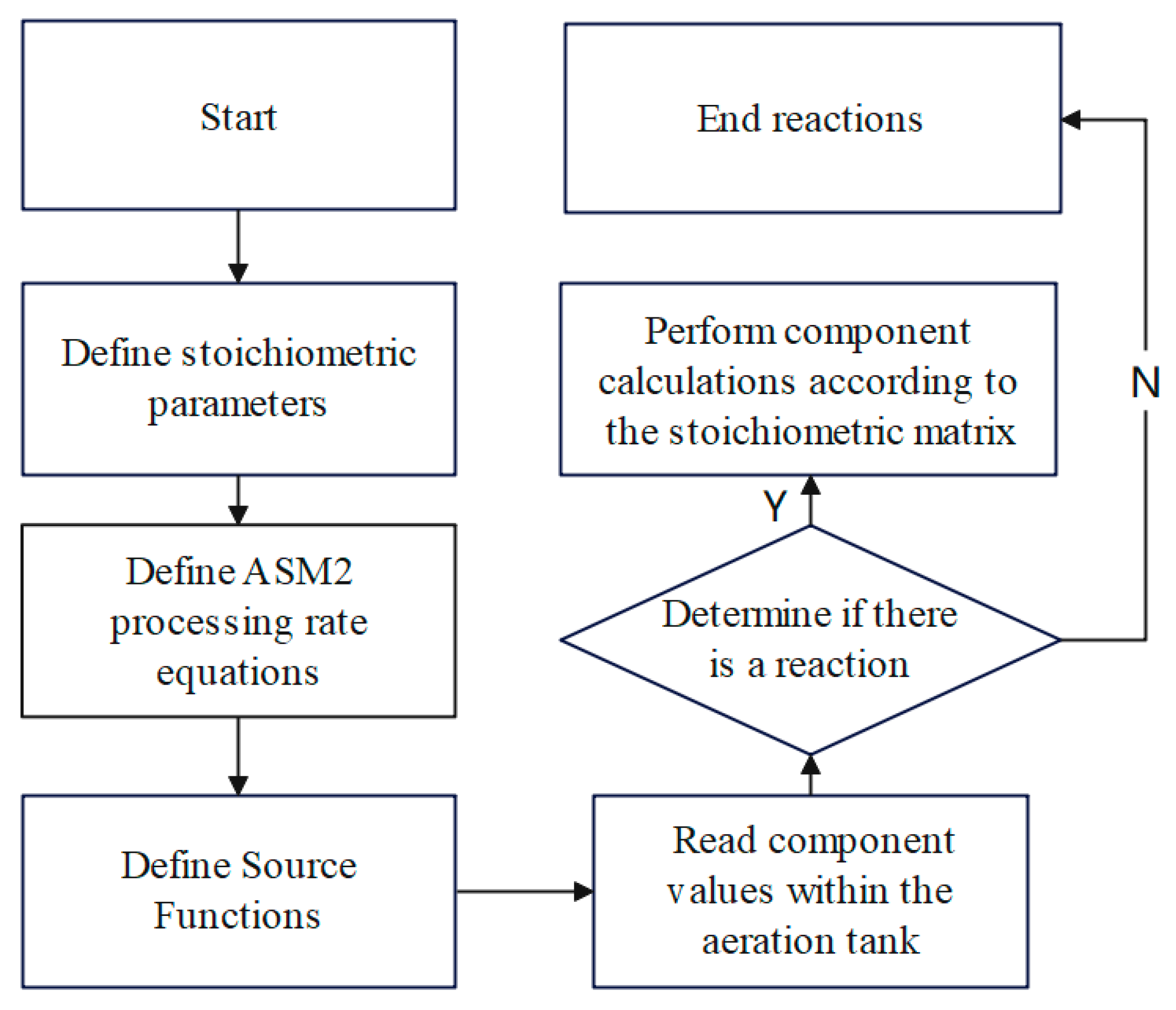





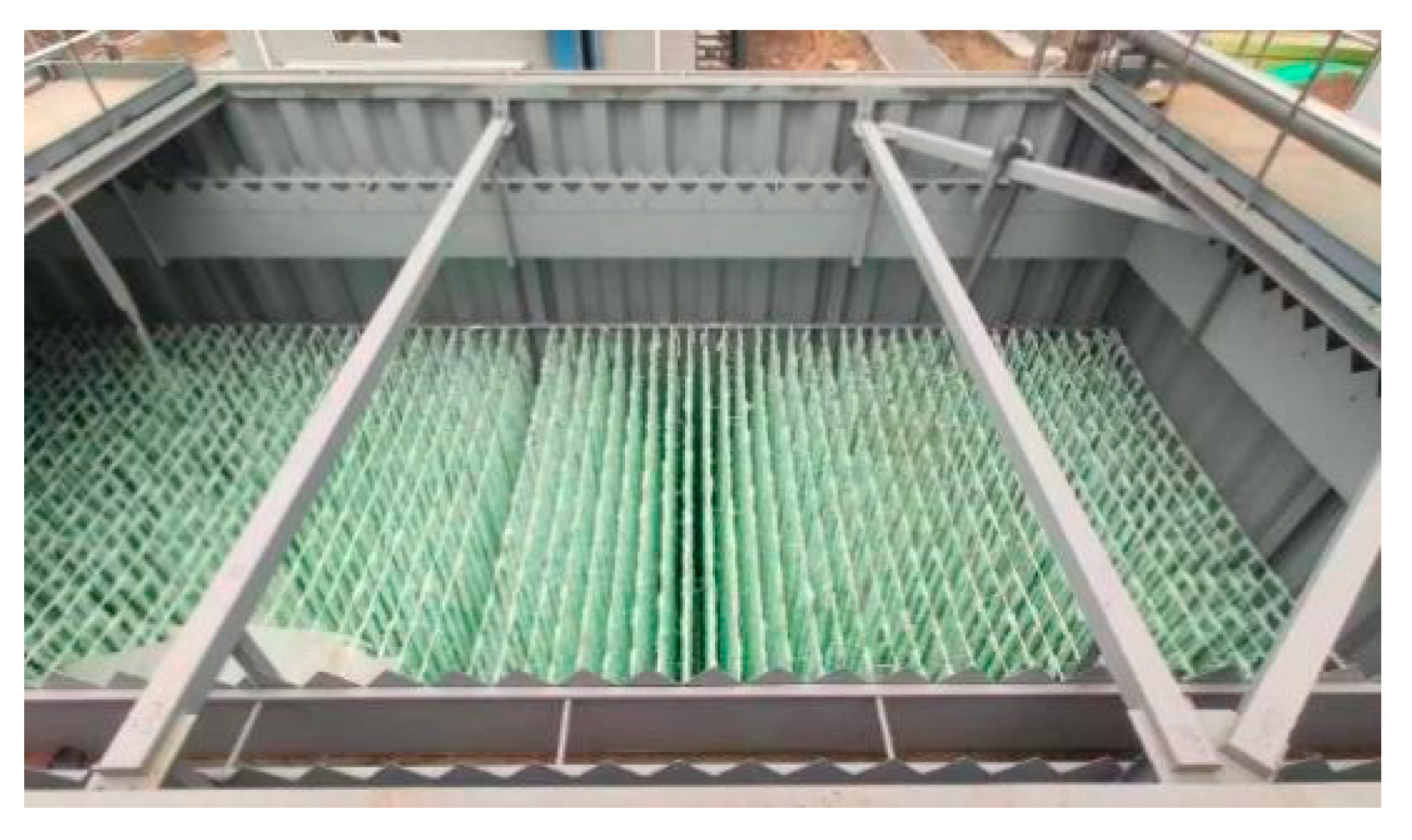
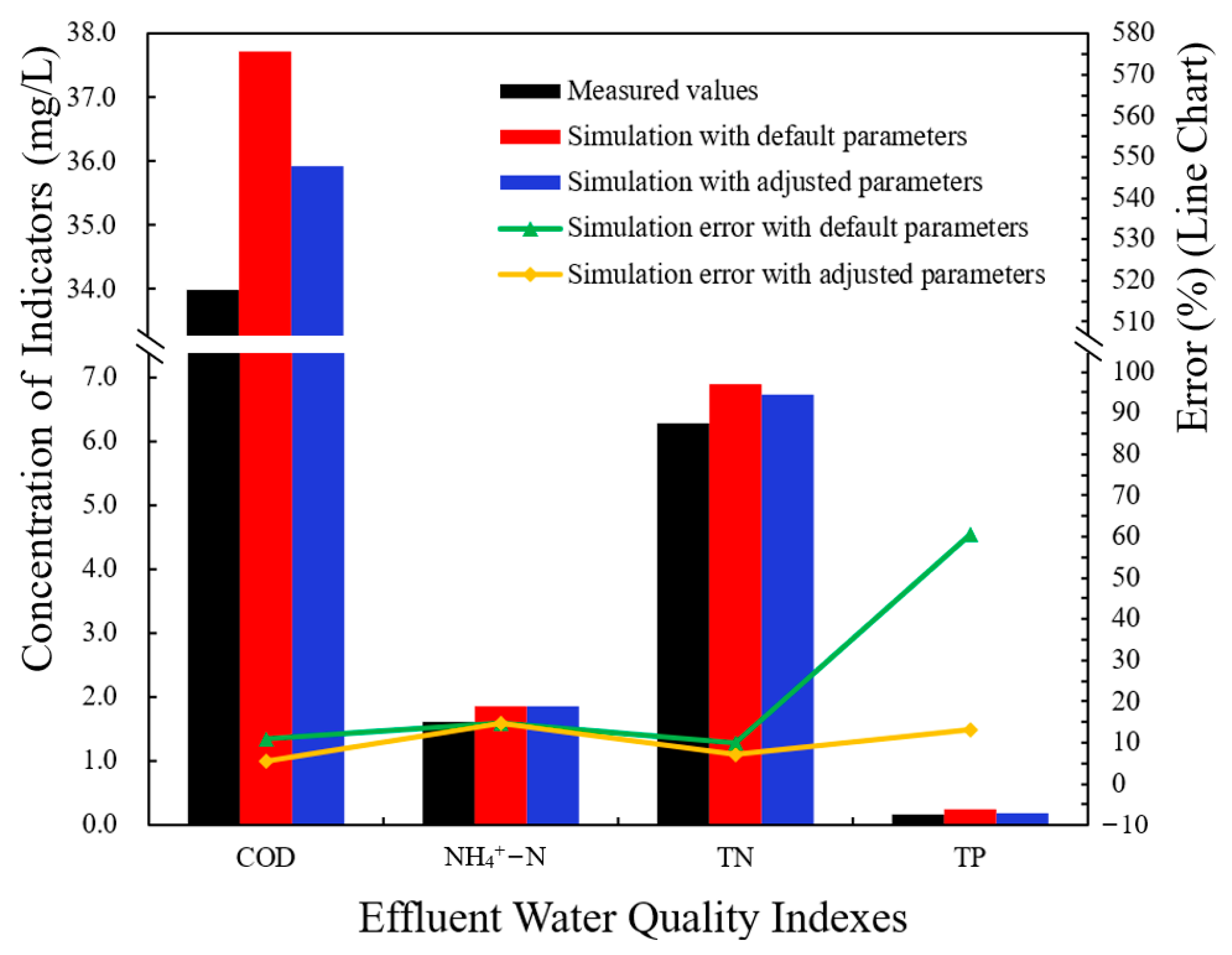

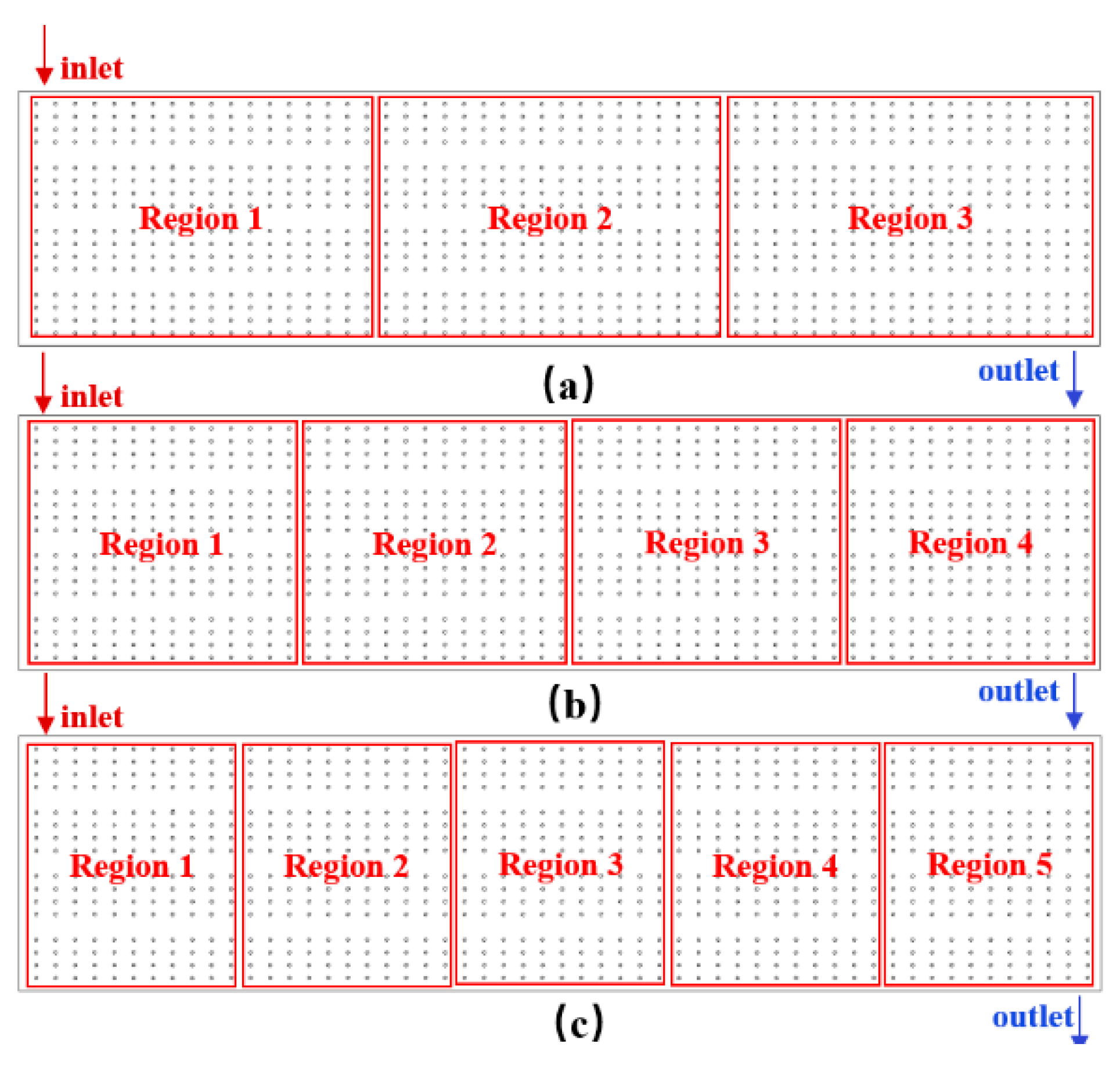



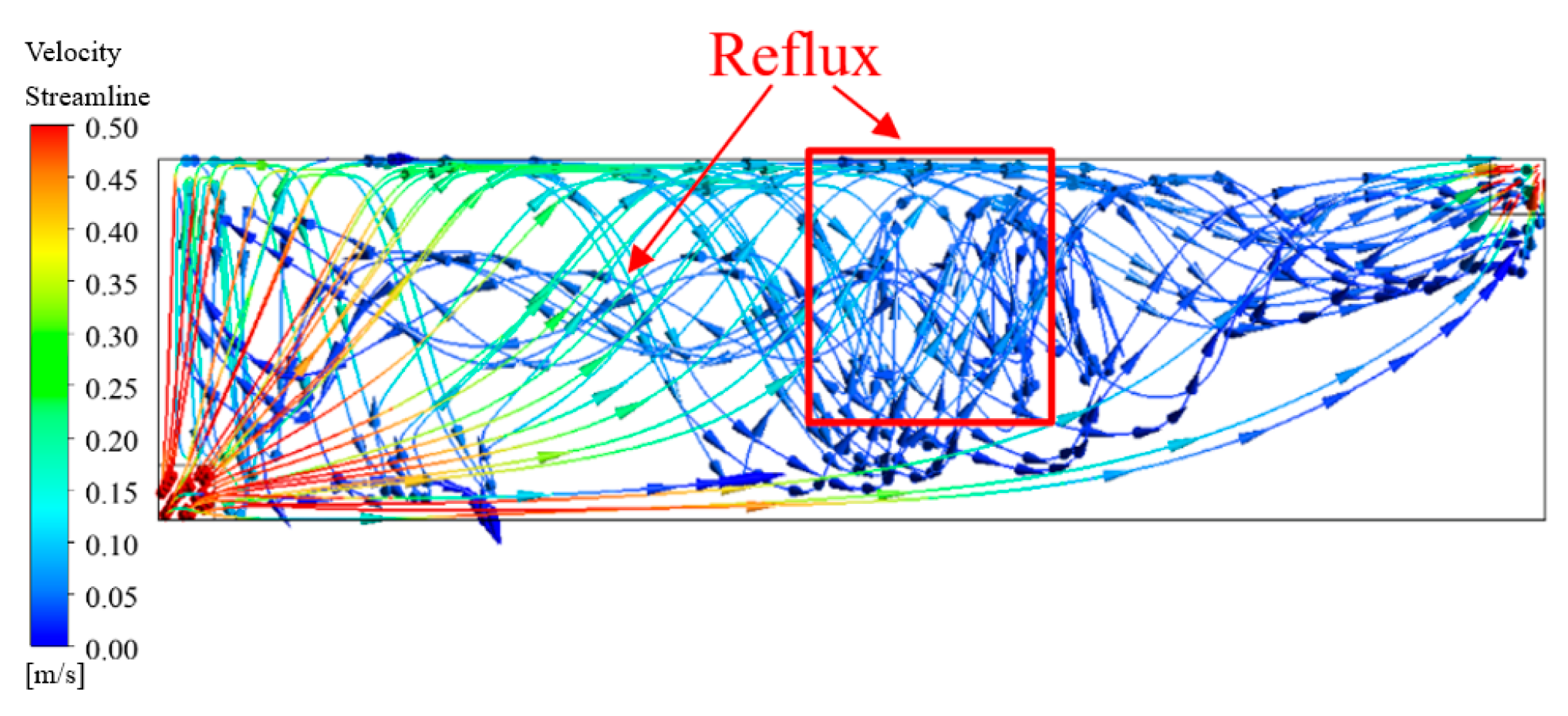

| Component | Number | Symbol | Definition |
|---|---|---|---|
| Dissolved components | 1 | Fermentation products (acetate) | |
| 2 | Bicarbonate alkalinity | ||
| 3 | Readily biodegradable substrate | ||
| 4 | Inert, non-biodegradable organics | ||
| 5 | Dinitrogen (N), 0.78 atm at 20 °C | ||
| 6 | Ammonium | ||
| 7 | Nitrate (plus nitrite) | ||
| 8 | Dissolved oxygen | ||
| 9 | Phosphate inert | ||
| Particulate components | 10 | Autotrophic, nitrifying biomass | |
| 11 | Heterotrophic biomass | ||
| 12 | Inert, non-biodegradable organics | ||
| 13 | “Ferric-hydroxide” (Fe(OH)3) | ||
| 14 | “Ferric-phosphate” (FePO4) | ||
| 15 | Phosphorus-accumulating organisms | ||
| 16 | Organic storage products of PAO | ||
| 17 | Stored poly-phosphate of PAO | ||
| 18 | Slowly biodegradable substrate | ||
| 19 | Particulate material as a model component |
| Wastewater Inflow Velocity (m/s) | Sludge Inflow Velocity (m/s) | Aeration Velocity (m/s) | Turbulence Intensity | Total Time(s) | Number of Iterations | Convergence Criteria |
|---|---|---|---|---|---|---|
| 0.7 | 0.6 | 0.096 | 10% | 3600 | 50 | <10−3 |
| Grid Size(m) | Flow Velocity(m/s) |
|---|---|
| 0.025 | 0.191 |
| 0.05 | 0.196 |
| 0.1 | 0.194 |
| 0.2 | 0.180 |
| Test Items | Test Methods | Results (mg/L) |
|---|---|---|
| COD | Dichromate Method | 33.99 |
| NH4+-N | Nessler’s Reagent Spectrophotometric Method | 1.62 |
| TN | Alkaline Persulfate Digestion UV Spectrophotometric Method | 6.28 |
| TP | Ammonium Molybdate Spectrophotometric Method | 0.16 |
| Suspended Solids | Gravimetric Method for Determination of Suspended Solids | 9 |
| Region | COD | NH4+-N | TN | TP | Average |
|---|---|---|---|---|---|
| 1 | 2.83 | 2.78 | 2.92 | 3.07 | 2.90 |
| 2 | 2.85 | 2.83 | 2.89 | 2.97 | 2.88 |
| 3 | 1.19 | 1.17 | 1.24 | 1.32 | 1.23 |
| 4 | 1.38 | 1.36 | 1.43 | 1.53 | 1.43 |
| Average | 2.06 | 2.03 | 2.12 | 2.23 | 2.11 |
| Improved rate | 14.97% | 14.72% | 15.53% | 16.58% | 15.47% |
| Aeration Schemes | Region 1 | Region 2 | Region 3 | Region 4 | Aeration Flow (m3/s) |
|---|---|---|---|---|---|
| Scheme b | 0.096 | 0.070 | 0.059 | 0.046 | 0.30 |
| Scheme d | 0.096 | 0.070 | 0.059 | 0.096 | 0.35 |
| Region | COD | NH4+-N | TN | TP | Average |
|---|---|---|---|---|---|
| 1 | 2.40 | 2.49 | 2.36 | 2.36 | 2.40 |
| 2 | 1.88 | 1.91 | 1.86 | 1.86 | 1.88 |
| 3 | 4.46 | 4.51 | 4.44 | 4.44 | 4.46 |
| 4 | 0.52 | 0.55 | 0.50 | 0.50 | 0.52 |
| Average | 2.13 | 2.11 | 2.16 | 2.22 | 2.15 |
| Improved rate | 29.04% | 33.31% | 24.90% | 19.93% | 26.66% |
Disclaimer/Publisher’s Note: The statements, opinions and data contained in all publications are solely those of the individual author(s) and contributor(s) and not of MDPI and/or the editor(s). MDPI and/or the editor(s) disclaim responsibility for any injury to people or property resulting from any ideas, methods, instructions or products referred to in the content. |
© 2025 by the authors. Licensee MDPI, Basel, Switzerland. This article is an open access article distributed under the terms and conditions of the Creative Commons Attribution (CC BY) license (https://creativecommons.org/licenses/by/4.0/).
Share and Cite
Shen, Z.; Tan, Y.; Xin, J.; Wang, C.; Zhang, S.; Cheng, L.; Peng, L.; Chen, Z. Water Quality Assessment and Aeration Optimization of Wastewater Aeration Tanks Based on CFD Coupled with the ASM2 Model. Water 2025, 17, 875. https://doi.org/10.3390/w17060875
Shen Z, Tan Y, Xin J, Wang C, Zhang S, Cheng L, Peng L, Chen Z. Water Quality Assessment and Aeration Optimization of Wastewater Aeration Tanks Based on CFD Coupled with the ASM2 Model. Water. 2025; 17(6):875. https://doi.org/10.3390/w17060875
Chicago/Turabian StyleShen, Zhihang, Yongqiang Tan, Jianjian Xin, Changfa Wang, Shunyu Zhang, Liangguo Cheng, Liang Peng, and Zhenlei Chen. 2025. "Water Quality Assessment and Aeration Optimization of Wastewater Aeration Tanks Based on CFD Coupled with the ASM2 Model" Water 17, no. 6: 875. https://doi.org/10.3390/w17060875
APA StyleShen, Z., Tan, Y., Xin, J., Wang, C., Zhang, S., Cheng, L., Peng, L., & Chen, Z. (2025). Water Quality Assessment and Aeration Optimization of Wastewater Aeration Tanks Based on CFD Coupled with the ASM2 Model. Water, 17(6), 875. https://doi.org/10.3390/w17060875




